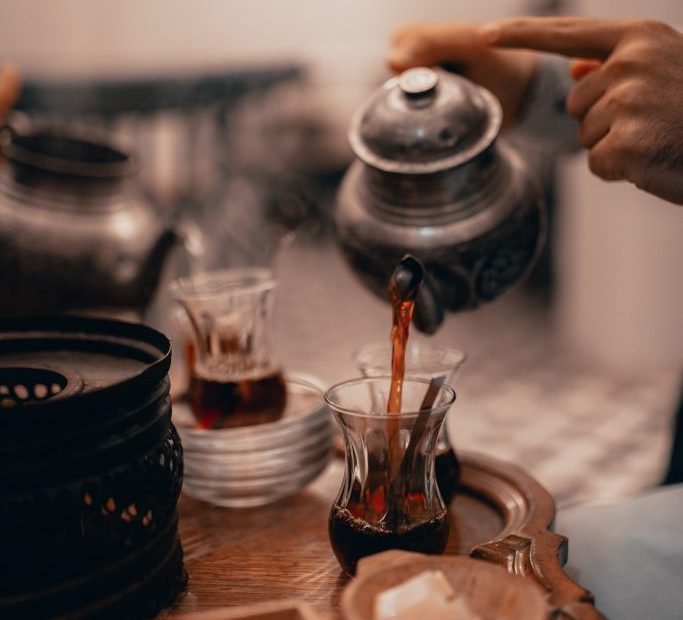What Does It Take To Make Tea?
Do you think that making tea is too difficult a task for you? Absolutely not, and I prove it to you in these five steps. I had already told you about the tricks of making tea here.
Today I will explain every single step and guide you step by step so that you can become a real pro in just a few minutes.
Yes because it only takes a few minutes to make a great cup of tea, a few accessories, a few directions but a lot of desire to enjoy a splendid moment with yourself or with others.
Are you ready to get started? Then let’s find out the ingredients of this recipe: what does it take to make tea?
What is needed
As we have said, you only need a few tools. Once this preparation is part of your daily life, you can then indulge yourself with the strangest and most original shaped cups and teapots, sophisticated accessories or perhaps beautiful travel memories.
To start, the ingredients are:
- water (preferably natural mineral water with low fixed residue and neutral pH)
- thermometer (specifically for tea) or a kettle with temperatures. Remember that there are types of tea that are more sensitive to temperatures, such as green tea, others less so. You can start with a classic black tea or an oolong tea
- timers (clocks, hourglasses, apps, heartbeats… are also fine)
- kettle or a small pot
- teapot with filter or infuser in case you want to use a leaf tea
- your favorite mug
- last but not least… His Majesty, tea!
Preparing tea: steps
Let’s see now, step by step, how to prepare tea. Follow our directions and let the pictures help you. If you have any doubts, write us your questions in the comments and we will answer them as soon as possible.
Step one: the water
Fill your kettle or pot with water. It is best if it is natural mineral water or microfiltered water. Tap water or distilled water is not recommended.
You can use your cup as a measuring cup to calculate the right amount. If you have to prepare tea for several people you will just pour as many cups as there are guests.
Second step: the temperature
At this point it would be easy to say, “Bring the water to a boil.” But it doesn’t. As many of you already know, each tea has its own ideal temperature. Excessive heat of the water would risk altering the taste. Which a tea connoisseur would never want to happen!
Have we scared you off? Remember that teas usually have a good degree of tolerance. The only one that doesn’t allow for mistakes is green tea, and you’ll notice it right away because your drink will immediately become bitter and allappant.
Recall the recommended temperatures:
- white teas: 80 – 85° C
- yellow teas: 80 – 85° C
- Chinese green teas: 80 – 85° C
- Japanese green teas: 70 – 75° C
- oolong teas: 85 – 95° C
- black (oxidized) teas: 85 – 95° C
- fermented teas: 90 – 95° C
If you do not have a thermometer or kettle with temperatures you can consider that the temperature of 80 – 85° C corresponds to the first boil, the first bubbles that form on the surface of the pot or kettle.
Step three: the quantity
While the water heats up, prepare your tea. If you decide to use leaf tea, place a quantity in the infuser in proportion to the number of cups to be brewed (roughly one tablespoon per cup, which corresponds to 2 to 2.5 grams). Or, if you opt for bagged tea, place one in each cup.
Once the water is ready, pour it directly onto the leaves or bag and not the other way around.
Step four: the infusion
It is not possible to establish an a priori time for the infusion of a tea, partly because it varies by type, by personal taste, by culture… but also because tea time is a time made up of moments, the moments of the heart of the person who brews it and of the person who will drink it.
However, it is true that for each type of tea there are recommended brewing times. Then it is up to our feeling to know when it is the right time to take that bag or infuser out of the cup or teapot. It’s a smell, it’s a taste, it’s a warmth, it’s a color-it’s the combination of these characteristics that says, “Now, it’s time!”
In general, the recommended times (also listed on the packages) are:
- white teas: 3 – 4 minutes
- yellow teas: 2 – 3 minutes
- Chinese green teas: 3 minutes
- Japanese green teas: 2.30 – 3 minutes
- oolong tea: 3 – 4 minutes
- black (oxidized) teas: 3 – 4 minutes
- fermented teas: 3 – 4 minutes
Fifth step: DO NOT DISTURB
After the necessary time has elapsed, all you have to do is strain the tea by removing the infuser and bag. If you want you can add sugar, honey, lemon, milk… but my advice is always to try tasting it au naturel. If you have followed all the steps to prepare the tea, you will be looking at an excellent beverage.
Enjoy this moment. The world can stay outside because now I am drinking my tea….
